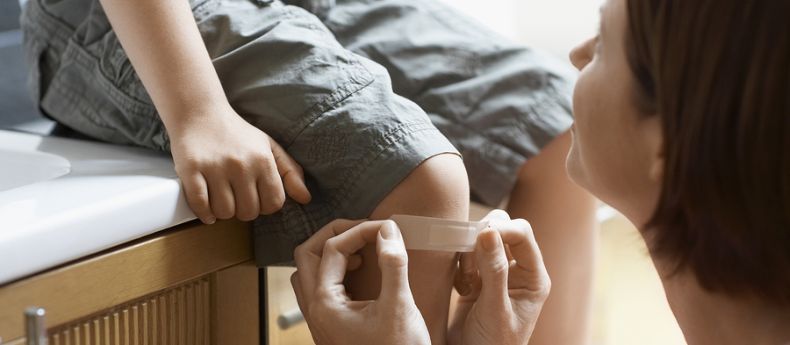
该不该去急诊?——浅谈伤口护理
无论是割伤、擦伤还是碰伤,人会受伤、出现伤口这是一个无法避免的现象。伤口会以各种形状和大小出现,刮胡子时不小心刮破下巴的小口、眉毛撕裂、切菜时切到手、从快速前进的自行车上摔下来造成的皮肉擦伤,人的一生中总会经历各种各样的伤口。
保持冷静的重要性
虽然伤口的处理方法不同,但有些真理是万用的,首先就是不要惊慌,尤其是涉及到孩子的时候。孩子们对于父母的情绪状态有着敏锐的察觉,如果受伤后爸爸妈妈传递给孩子的情绪不是平静和镇定,对处理伤口的难易程度来说可谓是火上浇油。实际上问题不用这么棘手,这也就是我想说的第二点,无论是哪一种伤口,多少都是会有疼痛感的。让受伤的孩子保持冷静是伤口护理的重要因素之一。
一般来说,伤口处理的原则就是将感染的风险降到最低,并争取让伤口痊愈后留下的疤痕越不明显越好。所有的割伤(切伤)都会留疤,但如果处理方式得当,疤痕可以很不明显。大部分的伤口都会流血,甚至血流不止。然而除非是一个大血管受损,可以通过按压达到止血目的。除了头皮损伤出血外,一般的出血量是可以忽略不计的,不必惊慌。
该不该去急诊室?
究竟什么样的伤口需要请专业医护人员进行评估和处理,这个问题很难回答。当拿不准主意时,可以求助您的家庭医生或急诊医生,即使只是寻求一个专业的意见或对伤口进行正确的清洗。无论是否需要求助专业医疗人员,在这之前您需要先自行对伤口进行简单处理。
预防感染的重要措施——清洗伤口。在受伤后快速清洗伤口可以降低感染的发生率,并让伤口愈合得更好。那么用什么清洗伤口呢?研究表明,用干净的自来水冲洗和用成本较高的无菌盐水冲洗差别并不大。在家中用自来水冲洗伤口并不会增加发生感染的风险。使用抗菌剂,如碘酒、酒精、过氧化氢(双氧水)处理伤口好处有限,但使用加压水,如用流动的水冲洗伤口更能有效地清除细菌。因此用水龙头或淋浴喷头的流动水冲洗伤口要比用浸湿的纱布或毛巾擦洗涂抹要好得多。
如果伤口出现以下情况时,请寻求专业医疗人员的评估:
- 皮下组织暴露
- 伤口沾染污垢或因疼痛难以清洗
- 动物咬伤
- 较深的刺穿伤口(尤其是刺穿鞋)
- 可能有异物残存,如玻璃或植被
- 影响关节功能
- 涉及面部
- 伤口下可能发生骨折
并不是所有的伤口都需要立即缝合。有些撕裂伤口较小,可以通过医用粘合剂处理。被动物咬伤要等待几天的时间再进行伤口缝合,前提是并非面部受损。头皮伤口一般会通过外科手术缝合。根据经验,面部伤口在24小时内闭合,其他的伤口在18小时内闭合。感染风险较高的伤口可能需要暴露数日,然后经专业医疗人员操作闭合。
伤口经过初步处理后,应涂抹抗生素软膏,然后用非粘性的敷料覆盖。多数伤口(无论是否经过缝合)在24小时后可用肥皂水轻轻冲洗,有些伤口在这之后就可以暴露在空气中了,但我建议您坚持每天两次用抗生素软膏涂抹伤口。缝合后的伤口在愈合过程中应避免游泳或长时间浸泡。缝针后多久拆线?这个时间需要根据伤口的位置决定,您的医生在缝合伤口时会给您一个大概的时间范围。
对于是否需要通过口服或静脉注射抗生素来防止伤口感染也存在争议。公式般地使用抗生素对健康人群来说并无益处,只有高风险的伤口——如动物咬伤或伤口延伸至关节处、软骨或肌腱撕裂才需要按照常规使用抗生素治疗。有关破伤风疫苗或加强注射的建议,请参阅美国疾病控制中心(CDC)的指导建议。
综上所述,当您或您的孩子受伤后,应:
- 1.保持冷静;
- 2.尽快用流动的净水清洗伤口;
- 3.通过适度按压止血(每五分钟释放一次压力检查是否已经止血);
- 4.确保伤口清洗干净后,涂抹抗生素软膏,用敷料覆盖;
- 5.基于本文的介绍,或您还有其他顾虑,请进一步考虑是否需要专业医疗人员评估伤口。
Copyright United Family Healthcare 2014 All right reserved - 京卫网审[2014]第1927号 - 京ICP备13017554号-4



